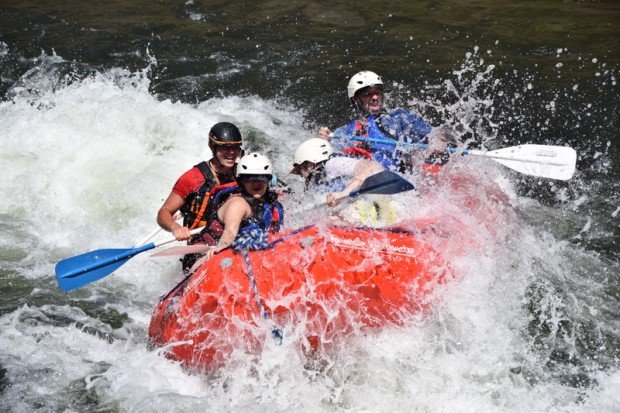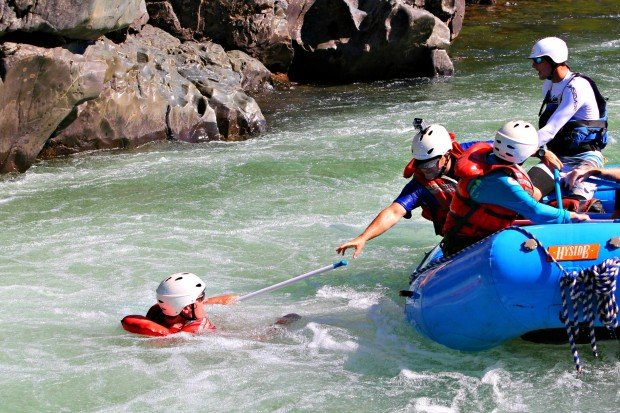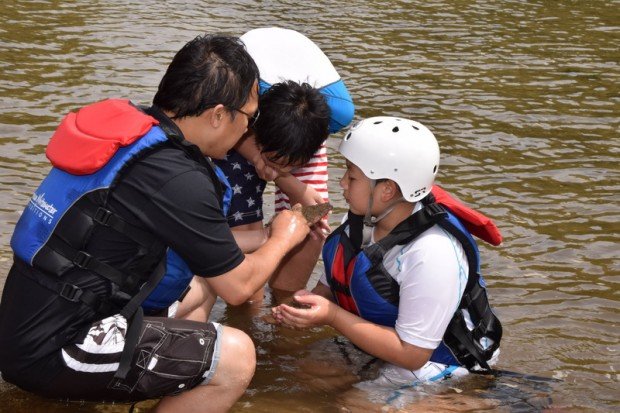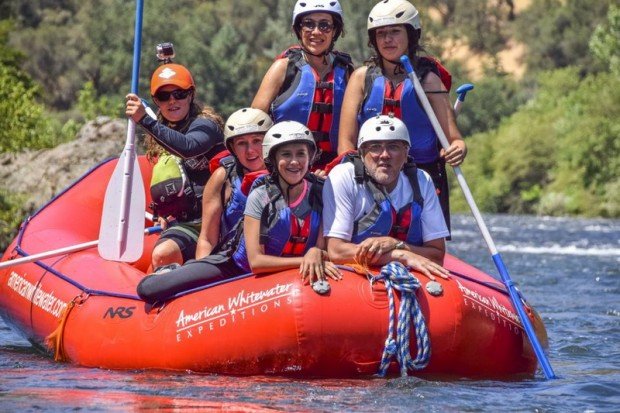Whitewater Rafting Safety: Shoot the Rapids and Live to Tell the Tale
A day spent on the river is great. A day spent on the river without anyone being bumped, bruised, contused, concussed or accidentally cracked in the head with a paddle is fantastic. And when awesomely responsible people, like you, take the time to prepare for the whitewater before you ever get your feet wet, it makes your trip a whole lot more fun!
To have the best time possible on your trip, you need to be safe on the river. So, to help you stay the course – in the raft, of course – here’s a rundown of whitewater rafting safety tips that will help make your next trip a whole lot safer.

Rafting Safety – A Long Tradition
Once upon a time, the rivers were untamed and unregulated, sort of like a very wet Wild West. Anyone could jump in a raft or hire a half-drunken guide to pilot them through treacherous rapids on dangerous rivers. Sometimes they survived; sometimes they didn’t. Some may argue those were the good ‘ol days.
In 1956, John D. Rockefeller built a resort that offered “floating” trips. No one came. It wasn’t until the late 60s and early 70s that whitewater guide companies became widely popularized and people realized that river rafting safety was kind of a big deal.
The best whitewater safety advice I can offer is to go with a professional whitewater outfitter, on any rafting trip. Commercial outfitters offer professional guides and quality equipment which make all the difference. Even though it may sound like fun to go out with a buddy on a plastic raft with a cooler, this is really bad idea and also super risky. Don’t take chances. Raft with a professional outfitter and you’ll have a terrific experience and memories to last a lifetime. – Heather Johnson, VP of River Expeditions
In 1959, the Safety Code of American Whitewater was adopted. This long and sometimes boring document details important and not-so-boring information, such as:
- How to prepare for a trip as an individual and as a group.
- How to make sure your raft doesn’t end up at the bottom of the river.
- And what to do if you end up at the bottom of the river, or at least are heading in that general direction.
The provisions of the Safety Code aren’t just empty words; they are words to live by. Here’s what they mean.
Rafting Safety Practices – How to Not Drown
 You don’t have to know how to swim to hit the river, but it’s a good idea to be comfortable in the water. If you can’t swim, we need to know that. Your personal flotation device (aka, a PFD or life jacket) will keep your head above the water. But it’s nice if you’re not flailing around when we’re trying to pluck you out of the river.
You don’t have to know how to swim to hit the river, but it’s a good idea to be comfortable in the water. If you can’t swim, we need to know that. Your personal flotation device (aka, a PFD or life jacket) will keep your head above the water. But it’s nice if you’re not flailing around when we’re trying to pluck you out of the river.
Never, ever, ever loosen your life jacket. Your guide will get very cranky if you break this rule, I promise.
You should wear a helmet. Most rafting companies require you to wear a helmet (we sure do). Your safety is our responsibility, and smacking rocks with your head hurts. And we’d rather you stay conscious for the rest of your rafting trip.
You should know what to do if you fall out of the raft. Yeah, it happens – so you need to be prepared. If and when it happens, grab onto the outside safety (OS) line and wait for someone to help you back in. If you can’t make it to the OS line, look for someone to offer you a paddle or toss you the throw bag. (A throw bag is a rescue device with a rope attached to it that can be thrown to an overboard rafter.) If we don’t get to you in the first few seconds, assume the whitewater “swimming” position: with your feet up and pointing downstream. (Like you’re sitting in a recliner in the water.) Don’t panic; however praying or cursing is permissible in this situation.
Likewise, you should also know what to do if someone else falls out of the raft. Throw them the OS line or give them a paddle to grab on to. Toss them the throw bag. It’s pretty simple, actually.
Being a big guy, I’m particularly interested that people in the boat with me know how to lift larger persons into a boat if said larger person would happen to have an ‘out of boat experience’. Instead of trying to use your muscles to haul them in, just grab the shoulder straps of their PFD, straighten your arms, and fall backwards into the center of the boat. Get a good grip and let your body weight do the work. Two small women, each grabbing a shoulder can haul my sorry butt right back in! – Will Hansen, RaftingTheWest.com
Another important thing to remember on the water is your T-grip. The rapids are fun; we get it. It’s easy to get excited, but excited people not holding the T-grip (the part of your paddle that looks like a T) accidentally crack other excited people in the heads with their paddles. Helmet or not, they won’t appreciate being smacked upside the noggin.
Finally, listen to your guide. You’ll have a pretty basic set of commands to follow. Lean left, lean right, bounce, paddle, stop paddling. Again – it’s all pretty simple, especially if you pay attention during the safety briefing. We promise not to talk your ear off, but there is some important information we need to convey. We’ll keep it short, but you need to pay attention!
If you’re not rafting with us, and choose to strike out sans guide, be confident in your abilities and your fellow rafters. Research your chosen section of river and let someone shore-side know where you’re going and when you plan to return. Never raft alone, after dark, or under the influence of drugs or alcohol. These are all very bad choices made by not smart people.
Rafting Safety Equipment – Stuff that Keeps You Safe
 Fantastic equipment is a must for river rafting safety. Outdated PFDs and poorly maintained rafts are the two main ingredients in a recipe for disaster. Rafts should be free of patches and/or holes. Paddles should be the correct size for each rafter. Inadequate equipment can result in serious injury — like getting cracked in the head — or even death. (Not trying to scare you, just trying to drive home the point: proper equipment is a must!)
Fantastic equipment is a must for river rafting safety. Outdated PFDs and poorly maintained rafts are the two main ingredients in a recipe for disaster. Rafts should be free of patches and/or holes. Paddles should be the correct size for each rafter. Inadequate equipment can result in serious injury — like getting cracked in the head — or even death. (Not trying to scare you, just trying to drive home the point: proper equipment is a must!)
Wetsuits, booties, thermals, and splash jackets will keep you toasty even in early spring weather. A day spent freezing your butt off isn’t much fun.
Once again: Helmets are a must while shooting the rapids. And, if you raft with us, you’ll be required to wear one. Don’t worry, they look fantastic!
And don’t forget the sunscreen, even if it’s overcast! The sun reflects off the water like a mirror and the worst burn of your life can come from a day on the river. A water bottle will keep you hydrated and a waterproof camera that clips to your PFD will document your journey.
Stay hydrated. Especially in hotter climate destinations like Central or South America, even though you are getting splashed by cool river water, it doesn’t mean your body is absorbing the liquid it needs. – Monika Sundem, Adventure-Life.com
At American Whitewater Expeditions, we take whitewater rafting safety very seriously, and we take great pains (get it?) to make our trips safe for everyone. Your repeat business keeps us afloat, and angry, injured people do not make excellent returning customers. We use 14-foot, self-bailing rafts (no duct tape or pinholes here!) and Coast Guard-approved, Type 5 commercial PFDs to keep your head above water. Sixty-inch, commercial-grade paddles are standard issue, but we keep lighter oars on hand for the young’uns. We’ve even got extra sunscreen … if you ask nice.
Safety Stats – Numbers that Prove You Aren’t Going to Die
 For those who like to have some stats to back up their safety, we’ve compiled a handful to ease your mind. These are proof positive that you will (probably) survive your first whitewater rafting trip and live to see another day on the river.
For those who like to have some stats to back up their safety, we’ve compiled a handful to ease your mind. These are proof positive that you will (probably) survive your first whitewater rafting trip and live to see another day on the river.
-
Most river rescues are self-rescues, meaning you (or someone on your boat) is the hero of the day.
-
An admittedly dated study by the NCBI out of West Virginia chronicles an overall injury rate of 0.263 per 1,000 rafters. That means only about one in every 250 rafters experience injuries. Those are some pretty good odds!
-
The rate of rafting fatalities is six to 10 for each 2.5 million user days on guided rafting trips, and 30% of rafting deaths are from unrelated health complications, like heart attacks.
Oh, and American Whitewater Expeditions has had a 100% safety record for the past 40 years. (Yes, we’re bragging.)
All this proves that you’re highly likely (although not quite guaranteed) to make it through the day and the rapids in one piece.
You’ll never have as much fun or as much of a rush (in our opinion!) on dry land as you will shooting the rapids. Know your river rafting safety tips, make sure your guide and equipment is top notch, and get ready to have the time of your life! It’s going to be a wild, wet, and memorable adventure! Happy rafting!
